Bitcoin (BTC) starts a new week on a high in more ways than one as BTC/USD seals its highest-ever weekly close.
After days of painfully slow progress, Bitcoin finally put in a breakout move to the upside to pass crucial levels.
Now ready to go “parabolic,” some argue, the largest cryptocurrency is now firmly back on the radar of traders after a week dominated by record highs in altcoins.
Will “Moonvember” start to live up to its name? Cointelegraph takes a look at what could end up moving the market in the coming days.
Large futures gap opens as BTC passes $65,000
It took a week’s patience, but bulls were finally rewarded overnight on Sunday as Bitcoin took flight, reclaiming its old all-time high of $64,900 from April.
As is so often the case during bull runs, the pace of gains was swift, with one hourly candle alone seeing $2,000 added to the spot price.
The timing was impeccable, coming just before the weekly close loomed and thus allowing a new record high of $63,270 for the weekly chart.
Going to be a big week
— Barry Silbert (@BarrySilbert) November 7, 2021
Predictably, reactions were overwhelmingly positive as higher short-term predictions returned.
“Resistance is futile,” podcast host Scott Melker summarized alongside a chart showing Bitcoin’s trend breakout.
Alongside the weekly all-time high came another milestone for the broader crypto market — the combined market capitalization of all tokens passed $3 trillion for the first time.
As Cointelegraph reported, optimism remains over Bitcoin’s longer-term potential, with opinions coalescing around the idea that the lion’s share of returns this cycle is still to come.
“People who are thinking it’s too late to buy BTC don’t realise how much higher it can still go in this cycle,” popular analyst Rekt Capital added.
Filbfilb, analyst and co-founder at trading platform Decentrader, meanwhile, flagged one of the few possible causes for correction in the form of the CME futures gap.
Given markets on Monday will open considerably higher than where they closed on Friday, the potential for spot to briefly return lower to “fill in” the resulting gap — in line with historical patterns — remains.
“Looks pretty bullish rn, might retrace to the cme gap but looks like fire overall imo,” he told Telegram channel subscribers.
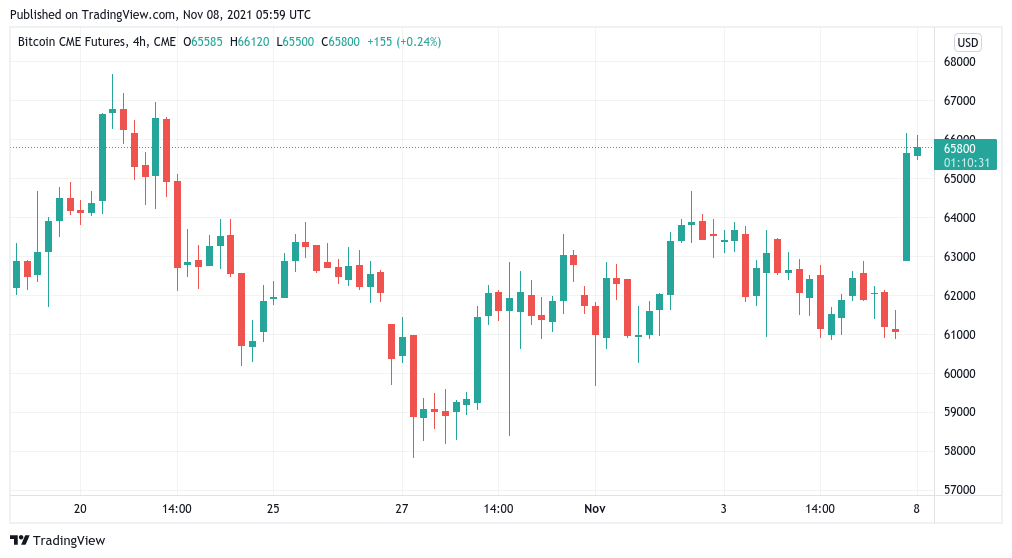 CME Bitcoin futures 4-hour candle chart. Source: TradingView
CME Bitcoin futures 4-hour candle chart. Source: TradingView
Funding grows as “extreme greed” awaits
Aside from the CME gap, another derivatives cue may yet put the cat among the pigeons on short timeframes.
Data at the time of writing showed that funding rates across exchanges were heading back toward unsustainable territory.
While not as high as during the run to $67,000 and above in October, highly positive funding often results in a price correction as traders turn complacent in longing the market.
For analyst Dylan LeClair, however, this was little concern, as no signs of leveraged longs increasing was evident.
“BTC +$2,000 over the last couple hours with no large uptick in futures open interest or perp funding,” he told Twitter followers.
“Current price action is a result of spot selling exhaustion, and not a result of a sudden increase in leverage. No sell side liquidity = gap upwards.”
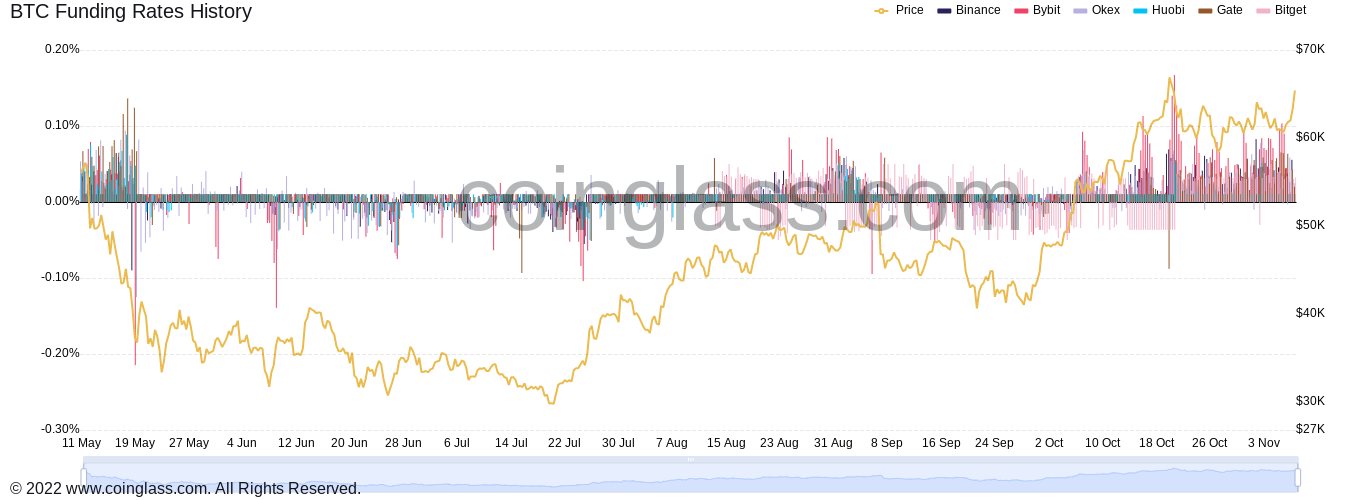 BTC funding rates chart. Source: Coinglass
BTC funding rates chart. Source: Coinglass
The mood for market sentiment overall, meanwhile, is edging toward “extreme greed,” as measured by the Crypto Fear & Greed Index.
At 75/100, however, the Index suggests that there are still at least 20 points left to run before classic top conditions enter.
 Crypto Fear & Greed Index. Source: Alternative.me
Crypto Fear & Greed Index. Source: Alternative.me
Miners still aren’t selling — Here’s why
With new all-time highs seemingly just around the corner, Bitcoin miners continue to show solid resolve and “hodl,” not selling their BTC.
Data from on-chain analytics service CryptoQuant shows that outflows from miner wallets, with few exceptions, have stayed flat in recent weeks and months.
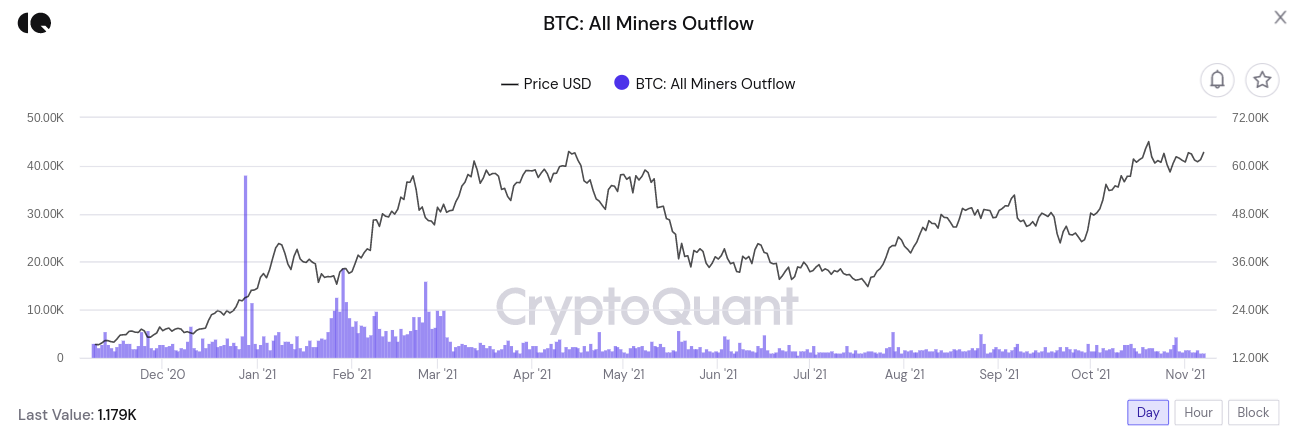 Bitcoin miner outflows chart. Source: CryptoQuant
Bitcoin miner outflows chart. Source: CryptoQuant
There may be a very good reason — since the May 2020 block subsidy halving, when miners’ revenue in BTC terms fell 50%, the United States dollar value of their income has shot up.
“Despite this reduction in BTC denominated income, miner revenue in USD is up 550% since the 2020 halving, and approaching an ATH of $62M+ per day,” fellow analytics firm Glassnode commented on Monday.
An accompanying chart showed the extent to which miners are capitalizing on their positions and how it has paid to hodl throughout the current four-year halving cycle.
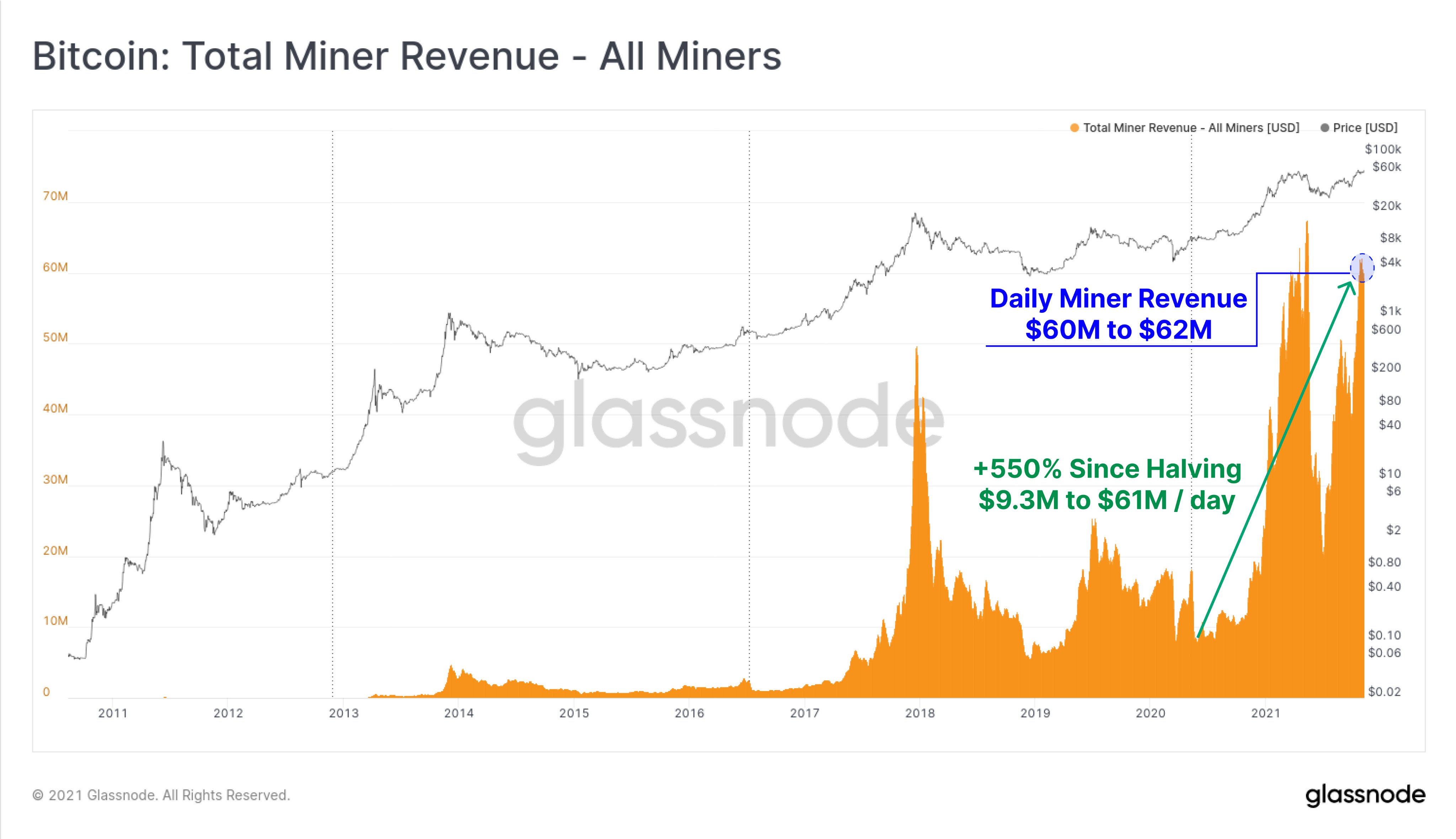 Bitcoin miner revenue vs. BTC/USD annotated chart. Source: Glassnode/Twitter
Bitcoin miner revenue vs. BTC/USD annotated chart. Source: Glassnode/Twitter
As Cointelegraph previously noted, miner behavior in Q4 is very different from the start of the year.
Outflows in Q1 were considerably higher, despite the fact that BTC/USD was trading at comparatively much lower levels than today.
Hash rate shows “sheer resiliency”
Accompanying the bullish mood among miners is a corresponding “up only” narrative for mining hash rate.
A measure of the processing power dedicated to maintaining the blockchain, the Bitcoin network hash rate continues to recover in leaps and bounds from the upheaval caused by China’s ban in May.
In record time, the metric has all but canceled out the event’s impact as miners relocate to the U.S. and elsewhere and existing operations add to their abilities.
“The recovery following the China mining ban has put on display the sheer resiliency, robustness, and decentralized nature of the Bitcoin network for all to see,” LeClair wrote in Twitter comments.
The hash rate varies depending on the estimate used, as its exact level cannot be calculated exactly. Blockchain’s seven-day average stated 161 exahashes per second (EH/s) at the time of writing, with the live all-time high at 168 EH/s.
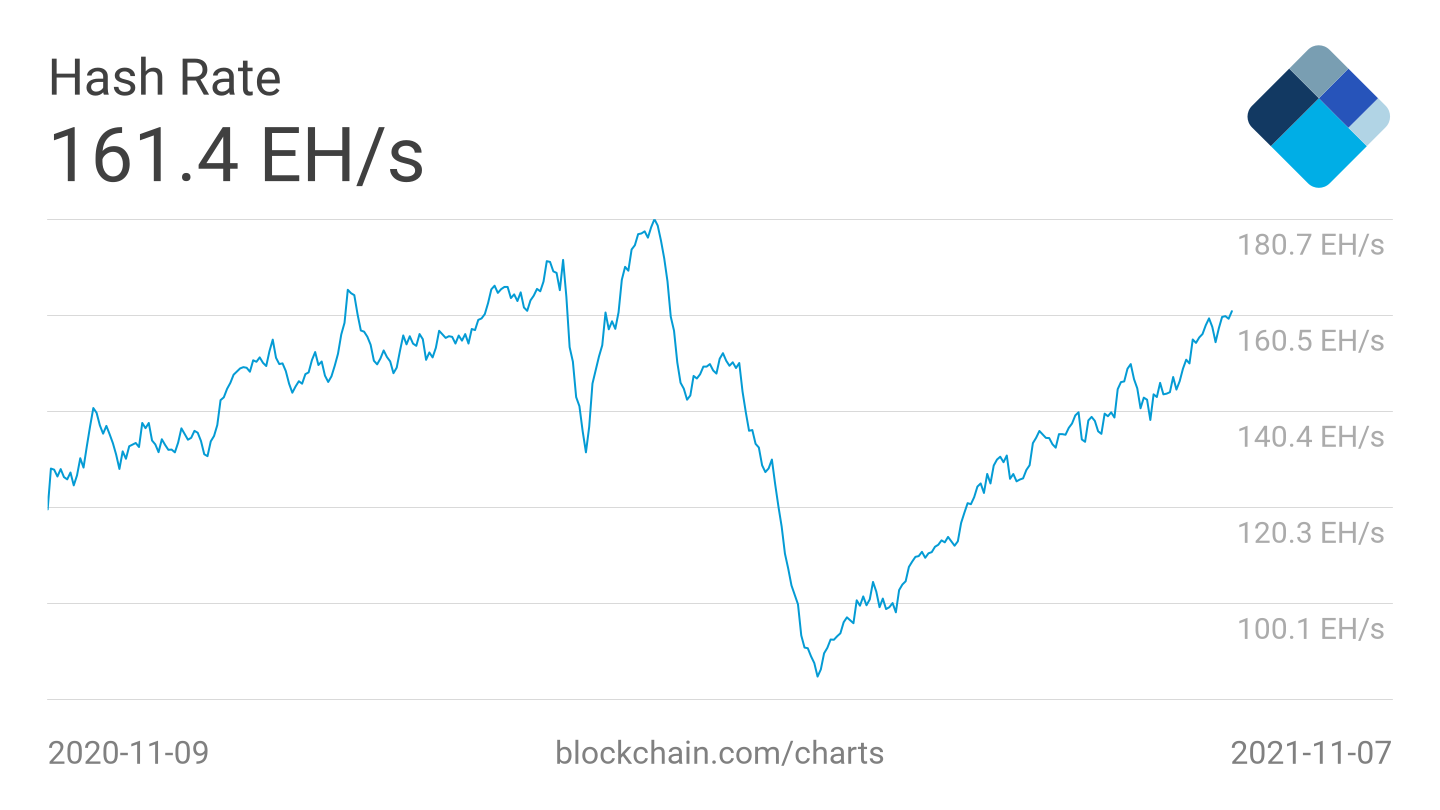 Bitcoin 7-day average hash rate chart. Source: Blockchain.com
Bitcoin 7-day average hash rate chart. Source: Blockchain.com
Beyond the hash rate, network difficulty remains set for further gains, having already seen eight straight increases in a row.
In five days’ time, at current prices, difficulty will rise by approximately another 3% to 22.33 trillion — itself closing in on all-time highs from before the China debacle.
Inflation worries with CPI data due
Inflation is still the name of the game on macro markets in what continues to be a beneficial headwind for Bitcoin’s attractiveness as a hedge.
Related: Top 5 cryptocurrencies to watch this week: BTC, DOT, LUNA, AVAX, EGLD
With U.S. consumer price index (CPI) data due this week, expectations are that the “disconnect” between projections and reality will widen.
The Federal Reserve, which recently signaled it would taper asset purchases, may even be forced to change course due to the current environment, one analyst told Bloomberg.
“We are of the view that there is upside risk in both these CPI numbers and as a result, there is actually a risk the Fed might actually accelerate the pace of asset purchases,” Citigroup senior investment specialist Mahjabeen Zaman said.
As Cointelegraph previously mentioned, CPI itself is a poor measure of inflation, as it excludes many of the assets that are seeing the biggest increase in value and price.
This has led to calls for Bitcoin adoption to preserve the purchasing power of both individual savers and cash-rich corporations and was a key factor in MicroStrategy’s move to convert huge portions of its balance sheet to BTC.
“I think that the killer use case for Bitcoin is store of value and treasury reserve asset, either for a family or corporation or government or institution or trust,” CEO Michael Saylor said in a separate media interview last week.






